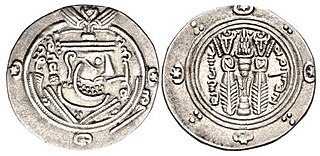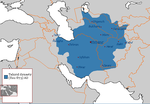
Abū Isḥāq Muḥammad ibn Hārūn al-Rashīd, better known by his regnal name al-Muʿtaṣim biʾllāh, was the eighth Abbasid caliph, ruling from 833 until his death in 842. A younger son of Caliph Harun al-Rashid, he rose to prominence through his formation of a private army composed predominantly of Turkic slave-soldiers. This proved useful to his half-brother, Caliph al-Ma'mun, who employed al-Mu'tasim and his Turkish guard to counterbalance other powerful interest groups in the state, as well as employing them in campaigns against rebels and the Byzantine Empire. When al-Ma'mun died unexpectedly on campaign in August 833, al-Mu'tasim was thus well placed to succeed him, overriding the claims of al-Ma'mun's son al-Abbas.

Ṭāhir ibn Ḥusayn, Arabic: طاهر بن الحسين, Tahir bin al-Husayn), also known as Dhul-Yamīnayn, and al-Aʿwar, was a Persian general and governor during the Abbasid Caliphate. Specifically, he served under al-Ma'mun during the Fourth Fitna and led the armies that would defeat al-Amin, making al-Ma'mun the caliph. He was then rewarded as governor of Khorasan, which marked the beginning of the Tahirids.

The Tahirid dynasty was a culturally Arabized Sunni Muslim dynasty of Persian dehqan origin, that ruled as governors of Khorasan from 821 to 873 as well as serving as military and security commanders in Abbasid Baghdad until 891. The dynasty was founded by Tahir ibn Husayn, a leading general in the service of the Abbasid caliph al-Ma'mun. For his support of al-Ma'mun in the Fourth Fitna, he was granted the governance of Khorasan. The Tahirids initially made their capital in Merv but later moved to Nishapur. The Tahirids, however, were not an independent dynasty—according to Hugh Kennedy: "The Tahirids are sometimes considered as the first independent Iranian dynasty, but such a view is misleading. The arrangement was effectively a partnership between the Abbasids and the Tahirids." Indeed, the Tahirids were loyal to the Abbasid caliphs and in return enjoyed considerable autonomy; they were in effect viceroys representing Abbasid rule in Persia. The tax revenue from Khorasan sent to the caliphal treasury in Baghdad was perhaps larger than those collected previously.

The Saffarid dynasty was a Persianate dynasty of eastern Iranian origin that ruled over parts of Persia, Greater Khorasan, and eastern Makran from 861 to 1003. One of the first indigenous Persian dynasties to emerge after the Islamic conquest, the Saffarid dynasty was part of the Iranian Intermezzo. The dynasty's founder was Ya'qub bin Laith as-Saffar, who was born in 840 in a small town called Karnin (Qarnin), which was located east of Zaranj and west of Bost, in what is now Afghanistan. A native of Sistan and a local ayyār, Ya'qub worked as a coppersmith (ṣaffār) before becoming a warlord. He seized control of the Sistan region and began conquering most of Iran and Afghanistan, as well as parts of Pakistan, Tajikistan and Uzbekistan.

Ya'qūb ibn al-Layth al-Saffār, was a coppersmith and the founder of the Saffarid dynasty of Sistan, with its capital at Zaranj. Under his military leadership, he conquered much of the eastern portions of Greater Iran consisting of modern-day Iran, Afghanistan, Turkmenistan, Uzbekistan, Tajikistan as well as portions of western Pakistan and a small part of Iraq. He was succeeded by his brother, Amr ibn al-Layth.
Nasr I was amir of the Samanids from 865 to 892. He was the son and successor of Ahmad ibn Asad.

Mazyar was an Iranian prince from the Qarinvand dynasty, who was the ruler (ispahbadh) of the mountainous region of Tabaristan from 825/6 to 839. For his resistance to the Abbasid Caliphate, Mazyar is considered one of the national heroes of Iran by twentieth-century Iranian nationalist historiography. His name means "protected by the yazata of the moon".

Khalid ibn Barmak was the first prominent member of the Barmakids, an important Buddhist family from Balkh, which converted to Islam and became prominent members of the Abbasid court in the second half of the 8th century. Khalid himself converted to Islam at the Umayyad court in the 720s, but joined the nascent Abbasid revolutionary movement in Khurasan, and played a significant role in the Abbasid Revolution that toppled the Umayyads. He enjoyed close relations with the first Abbasid caliph, al-Saffah, functioning as his chief minister and introducing innovations in record-keeping. Under al-Saffah's successor, al-Mansur, Khalid's influence decreased, but he still occupied significant provincial governorships in Fars, Tabaristan, and Mosul. As an administrator, he distinguished himself for his fairness, especially in matters of taxation, and was a popular governor. He appears to have briefly fallen into disgrace around 775, but he managed to recover, helped by the rapid rise of his son, Yahya. Khalid's ties to the Abbasid dynasty were soon strengthened when his grandson, al-Fadl ibn Yahya, became the foster-brother of the future caliph Harun al-Rashid, while Yahya became the prince's tutor. Khalid died in 781/2, shortly after returning from an expedition against the Byzantine Empire.

Amr ibn al-Layth or Amr-i Laith Saffari was the second ruler of the Saffarid dynasty of Iran from 879 to 901. He was the son of a whitesmith and the younger brother of the dynasty's founder, Ya'qub ibn al-Layth al-Saffar.
Tahir ibn 'Abdallah was the Tahirid governor of Khurasan from 845 until 862. He was the governor for seventeen years under Abbasid caliph al-Wathiq, al-Mutawakkil and al-Muntasir.

Abdallah ibn Tahir was a military leader and the Tahirid governor of Khurasan from 828 until his death. He is perhaps the most famous of the Tahirids. His career spanned twenty-five years under three caliphs, al-Ma'mun, al-Mu'tasim, and al-Wathiq. Militarily, he is known for defeating the powerful rebels Nasr ibn Shabath in the Jazira and Ubaydallah ibn al-Sari in Egypt.

The Bavand dynasty, or simply the Bavandids, was an Iranian dynasty that ruled in parts of Tabaristan in what is now northern Iran from 651 until 1349, alternating between outright independence and submission as vassals to more powerful regional rulers. They ruled for 698 years, which is the second longest dynasty of Iran after the Baduspanids.

Abū Muḥammad al-Ḥasan ibn Zayd ibn Muḥammad ibn Ismaʿīl ibn al-Ḥasan ibn Zayd, also known as al-Dāʿī al-Kabīr, was an Alid who became the founder of the Zaydid dynasty of Tabaristan.
Rāfi‘ ibn Harthama was a mercenary soldier who in the turmoils of the late 9th century became ruler of Khurasan from 882 to 892.
The Mikalid family, also known as the Mikalis, was a prominent Iranian aristocratic family of Khorasan from the 9th century to the 11th century. They were descended from the pre-Islamic nobility of Samarkand.
Abd-Allah Mikali was an Iranian statesman from the Mikalid family, who served the Saffarids, and later the Abbasids.
Shah ibn Mikal or al-Shah ibn Mikal, was an Iranian nobleman from the Mikalid family, who served as a military commander of the Tahirid dynasty and Abbasid Caliphate.

The Qarinvand dynasty, or simply the Karenids, was an Iranian dynasty that ruled in parts of Tabaristan (Mazandaran) in what is now northern Iran from the 550s until the 11th-century. They considered themselves as the inheritors of the Dabuyid dynasty, and were known by their titles of Gilgilan and Ispahbadh. They were descended from Sukhra, a Parthian nobleman from the House of Karen, who was the de facto ruler of the Sasanian Empire from 484 to 493.
The Muslim conquest of Khorasan was the last phase of the heavy war between the Rashidun caliphate against the Sassanid Empire.
Abu Abdallah Muhammad ibn Ibrahim ibn Mus'ab was a Mus'abid military commander and provincial official for the Abbasid Caliphate. He served as the governor of Fars from 846–7 until his death.












